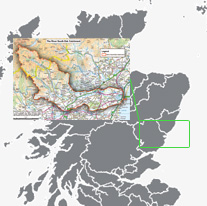Climate Change
Overall, Scotland has become much wetter during the winter since 1961 while areas in the east are becoming drier in the summer months.
Rain and snowfall in winter has increased by almost 60% in the north and west. Scotland’s yearly average of rain and snowfall has increased by 20%. If we look at information on Scottish river flow, we can see an increase in high flow frequencies for western rivers over the past 20 years.
In contrast, in the east, values were highest in the 1950s and 1960s. Average spring, summer and winter temperatures have risen by more than 1.0°C since 1961. Over the same period, the number of days of frost (both air and ground frost) across the country has fallen by over 20% and the growing length of the seasons has increased significantly, with the greatest change happening at the beginning of the season (See http://www.sepa.org.uk/consultation/closed/2008/swmi_scotland/contents.html.)
By the 2080s, scientists predict that:
- Yearly temperatures across Scotland will rise by up to 3.5ºC in the summer and 2.5°C in the winter;
- Summers will become generally drier across Scotland (there may only be a slight reduction in rainfall in the northwest but as much as a 40% reduction in the south and east);
- Scotland's sea levels will rise, perhaps by up to 600 millimetres around the mainland;
- There will be more extreme rainfall in the east, with an expected increase every two years of up to 25% of rain falling in 24 hours from storms ; and
- The average snowfall will reduce - by up to 90% depending on the area, and winters with no snow may become normal in some parts. (See http://www.angus.gov.uk/sustainability/climatechange.htm.)
Significant changes in average temperature, rainfall and snowfall as predicted above, are likely to have a considerable
effect on water availability within the area. The need for water is likely to increase across the East coast, together with the need for a greater public water supply.


